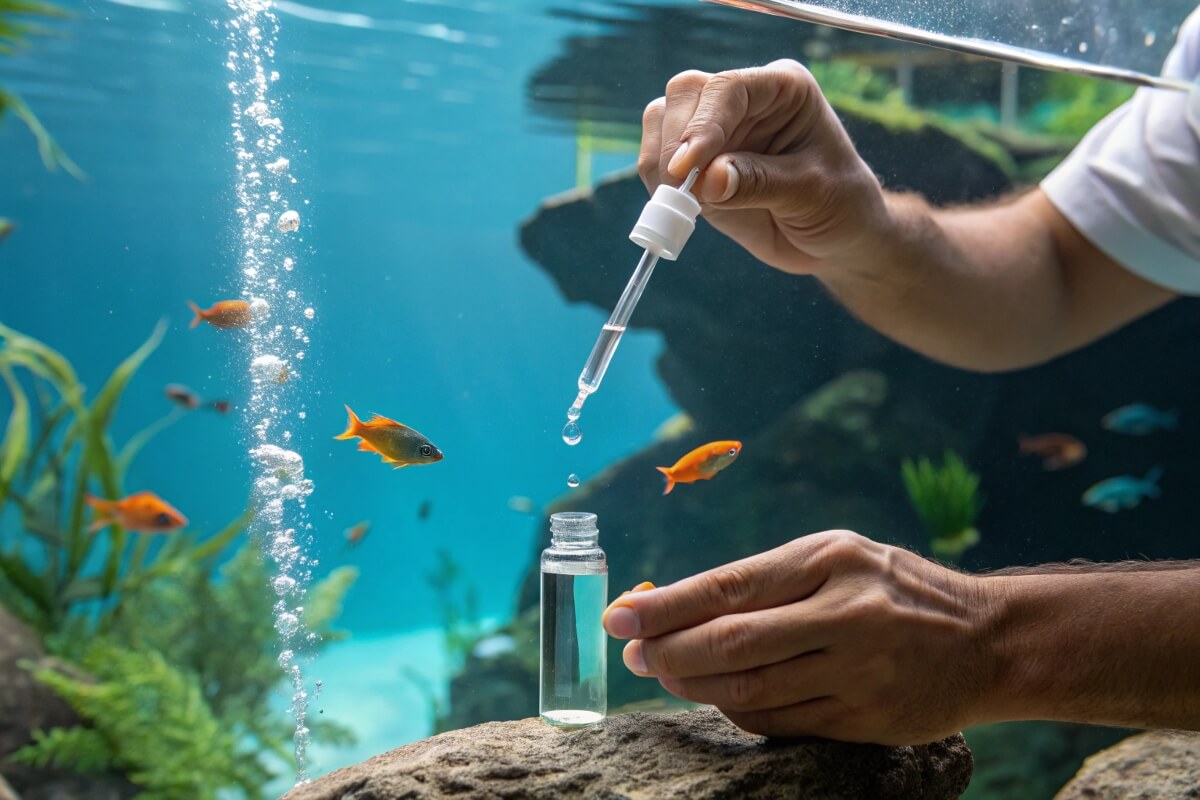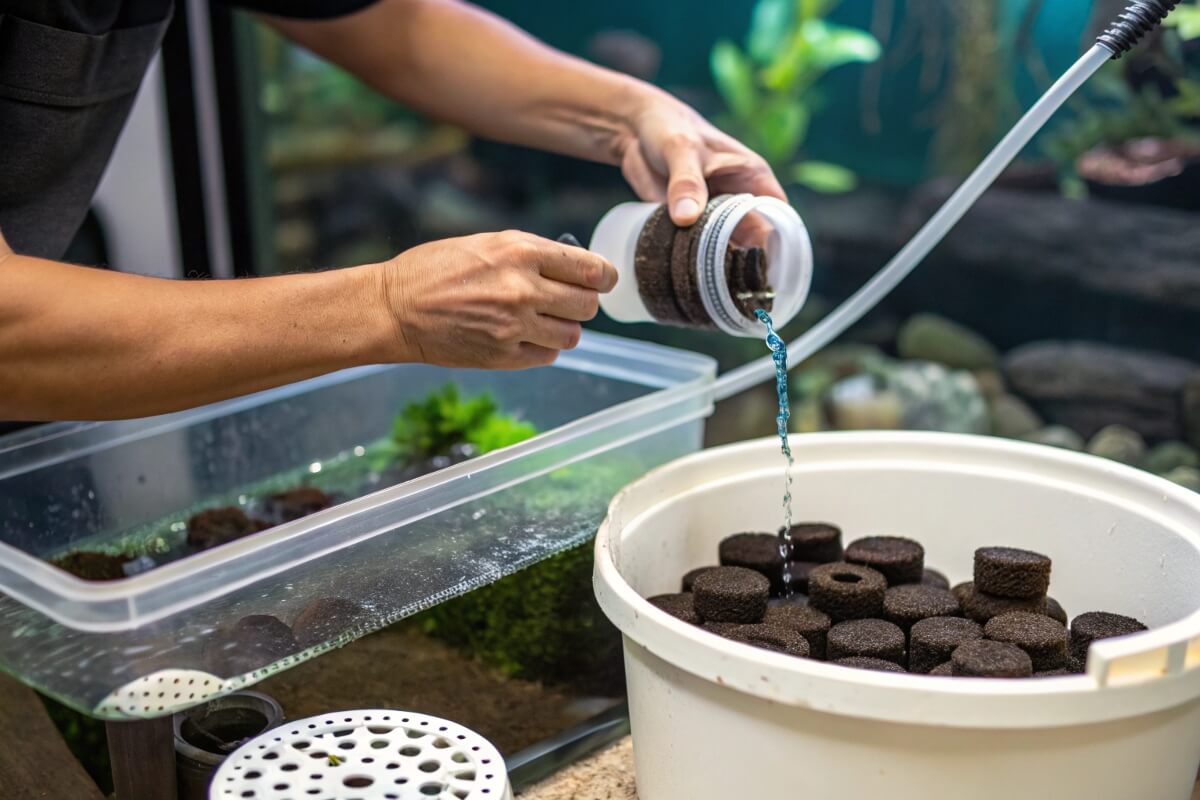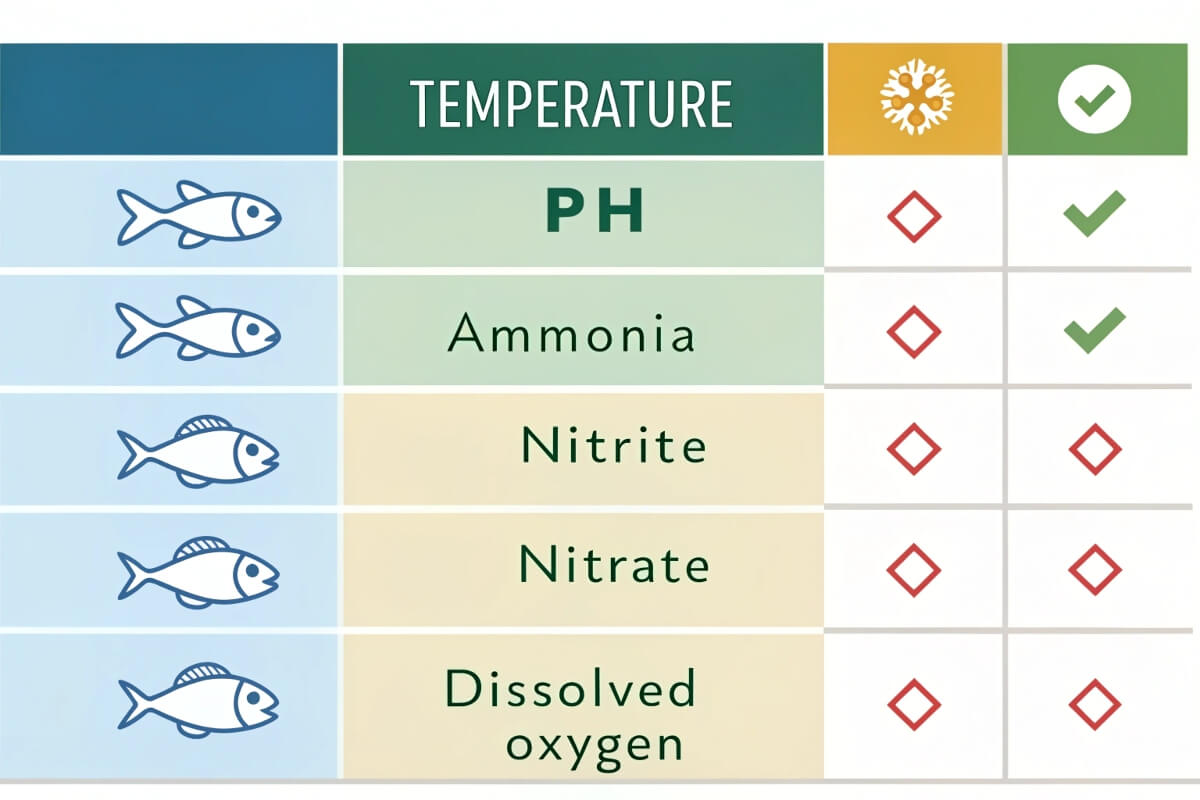Maintaining Water Quality in Fish Tanks: A Step-by-Step Guide for Farmers?
Struggling with sick fish and low yields? Poor water quality silently ruins profits and causes constant worry. This guide gives clear, practical steps for healthy fish tanks and successful farming.
Maintain fish tank water quality by regularly testing key parameters like ammonia and pH. Perform consistent water changes. Use a reliable filtration system. Understand the nitrogen cycle to prevent toxic buildup. Proper care ensures healthy fish and productive farming.

Keeping fish healthy really depends on the water they live in. It's the foundation of everything in aquaculture. Let's look closer at exactly what you need to do to maintain that perfect environment in your tanks.
How to maintain fish tank water quality?
Confused about how to keep water perfect? Bad advice can lead to disaster quickly and cost you valuable fish. Focus on these essential, proven actions for success in your fish farming operation.
To maintain quality, monitor crucial parameters: pH, temperature, ammonia, nitrite, and nitrate levels. Regular water changes are essential. Ensure your filtration system is working correctly to process waste. These steps are key to a healthy fish environment.
[^1] in an aquaculture environment, showing the flow from fish waste to bacteria and back to plant life](https://www.bancysolutions.com/wp-content/uploads/2025/04/conceptual-illustration-of-the-nitrogen-cycle-with.jpg)
Water quality is everything in fish farming. As someone who has worked closely with farmers for years, I can tell you it directly impacts fish health, their growth rate, and ultimately, your farm's survival. Poor water causes stress, opens the door for diseases, and leads to financial loss. I've seen firsthand how critical consistent management is. The most important thing to understand is the nitrogen cycle, which happens inside your tank and filter.
Understanding the Nitrogen Cycle
Fish produce waste, mostly in the form of ammonia (NH3). Even in small amounts, ammonia is highly toxic to fish. Thankfully, nature has a solution. Beneficial bacteria, living mainly in your filter system, convert this toxic ammonia into nitrite (NO2). Nitrite is also very toxic to fish, so the process isn't finished yet. A different group of beneficial bacteria1 then converts the nitrite into nitrate (NO3). Nitrate is much less harmful than ammonia or nitrite, but high levels can still stress fish and fuel algae growth. The main way we remove nitrates is through regular partial water changes.
Testing your water regularly is not optional; it's essential. You need reliable test kits to know what's going on. Here are the main things to check:
| Parameter | Importance | Ideal Range (General) | Notes |
|---|---|---|---|
| pH | Affects fish metabolism and ammonia toxicity | 6.5 - 8.5 (Varies) | Check needs for your specific fish species |
| Temperature | Impacts fish activity, oxygen levels, immunity | Varies by species | Crucial for cold-water vs. tropical fish |
| Ammonia (NH3) | Highly toxic fish waste product | 0 ppm | Any reading indicates a potential problem |
| Nitrite (NO2) | Highly toxic intermediate product | 0 ppm | Shows the cycle is working, but maybe not fully |
| Nitrate (NO3) | Less toxic end product, fuels algae growth | < 40-50 ppm (Varies) | Removed primarily by water changes |
| Dissolved Oxygen (DO) | Essential for fish breathing | > 5 ppm (Varies) | Lower in warm water or high stocking densities |
At Bancy, we focus on providing tanks that make your job easier. Our durable, collapsible fish tanks use high-quality, non-reactive materials. Combined with our unique double-welding technique for superior sealing, this helps prevent contaminants from leaching into the water and ensures tank integrity. It gives you a stable, reliable base, making it simpler to manage the water quality2 effectively.
How do you maintain fish water quality?
Knowing what parameters to control is one thing. Doing it wrong wastes time, money, and risks your fish stock. Let's cover the practical methods you need for consistent success.
Maintain water quality using reliable test kits regularly. Perform scheduled partial water changes, typically weekly. Clean your filter media correctly, preserving beneficial bacteria. Avoid overfeeding your fish, as uneaten food pollutes the water. These methods form a solid routine.

Let's get practical about the day-to-day work. Maintaining good water quality3 means having a solid routine and using the right techniques consistently. It's about building good habits.
Testing Methods
You need to test your water, but how? You generally have two main choices: liquid test kits4 or test strips. Liquid kits usually give you more accurate results, especially when measuring low levels of things like ammonia or nitrite. They involve adding specific drops of chemicals to a water sample and comparing the resulting color to a chart. They take a bit more time. Test strips are much faster and easier – just dip the strip, wait a moment, and compare colors. They are great for quick checks and tracking general trends, but might not be as precise. I often suggest liquid kits for the critical ammonia and nitrite tests, but strips can be fine for pH or nitrate once your tank is stable. Choose what fits your budget and how much time you have, but be consistent with whichever method you pick.
Water Change Procedures
Regular partial water changes are absolutely vital. They remove the buildup of nitrates and other dissolved waste products, and they also replenish essential minerals that get used up over time.
| Factor | Recommendation | Why |
|---|---|---|
| Frequency | Weekly is a good starting point for most tanks | Prevents gradual decline in water quality |
| Volume | Typically 10-25% of the tank volume | Avoids large, sudden changes in water chemistry that shock fish |
| Water Prep | Use a dechlorinator if using tap water | Chlorine and chloramine kill fish and beneficial filter bacteria |
| Temperature | Match new water temperature closely to tank water | Prevents temperature shock, which stresses fish |
Filter Maintenance
Your filter is the heart of your tank's life support system because it houses most of the beneficial bacteria doing the nitrogen cycle work. You need to clean it occasionally to remove trapped debris, but never wash the filter media (sponges, bio-balls, ceramic rings) under untreated tap water! The chlorine will kill your bacteria colony. Instead, gently rinse the media in some of the tank water you removed during a water change. This keeps the bacteria safe.
Feeding Strategy
Overfeeding is probably the most common mistake in fish keeping. Only feed your fish an amount they can completely consume within a few minutes, usually once or twice a day. Any uneaten food sinks, rots, and produces ammonia, directly polluting the water and overloading your filter.
The specific routine might vary slightly. For example, a very large Bancy fish tank might handle waste better than a small one due to the sheer volume of water diluting the waste. However, testing is always the best guide. I also advise clients in warmer regions like Southeast Asia about the importance of extra aeration, since warm water naturally holds less dissolved oxygen. Our Bancy tanks are highly customizable, so we can ensure they are set up with the right filtration and aeration systems for your specific location and needs.
How to maintain a fish tank for beginners?
New to fish farming or aquaculture? It can feel overwhelming with so much information and so many things to track. Start with these simple, foundational steps to build confidence and avoid early mistakes.
Beginners should first focus on learning the nitrogen cycle. Start with a properly sized tank and fewer, hardy fish. Test water parameters daily initially, then settle into a weekly routine. Perform regular weekly water changes (around 10-15%) consistently. Patience is key.

Starting out in fish farming is exciting, but it's easy to get overwhelmed. Let's break it down into manageable steps. The absolute most important concept for any beginner to grasp is the nitrogen cycle5. Don't let the name intimidate you!
The Nitrogen Cycle Simplified for Beginners
Think of it simply:
- Fish eat and produce waste. This waste creates invisible ammonia in the water. Ammonia is poison for fish.
- You need good "bugs" (beneficial bacteria6) to grow, mostly inside your filter. These first bugs eat the ammonia poison.
- When eating ammonia, these bugs produce another invisible poison called nitrite.
- Different good bugs then eat the nitrite poison.
- These second bugs turn nitrite into nitrate, which is much less harmful but still needs to be controlled.
- You remove the nitrate by doing regular partial water changes.
The process of growing these good bugs in a new tank is called "cycling7." It takes time, often several weeks. This is why you should never put a lot of fish into a brand new tank. You need to cycle it first, usually by adding an ammonia source (without fish) and testing the water until ammonia and nitrite consistently read zero.
Beginner's Checklist
Here’s a simple plan to follow:
| Step | Action | Why Important |
|---|---|---|
| 1. Cycle the Tank | Set up tank & filter, add ammonia source (no fish yet!), test | Grows essential bacteria before fish are stressed by waste |
| 2. Choose Hardy Fish | Start with species known to be tolerant (like Tilapia, Catfish) | More forgiving if you make small mistakes early on |
| 3. Start Small | Add only a few fish initially; don't fully stock the tank | Less waste produced = easier water quality management |
| 4. Test Frequently | Test Ammonia & Nitrite daily during cycling and first few weeks | Catches dangerous spikes quickly before fish get sick |
| 5. Water Changes | Once cycled, do weekly 10-15% changes reliably | Keeps nitrates low and water fresh |
| 6. Feed Sparingly | Feed only what fish eat in 2-3 minutes, once or twice daily | Prevents pollution from uneaten food decaying |
The best advice I can give a beginner is: be patient. Rushing the process, especially cycling and stocking, almost always leads to problems and dead fish. Using high-quality, reliable equipment from the start also helps reduce beginner stress. Knowing your Bancy tank is robust, made from safe materials, and expertly sealed with our double-weld technology means you have one less major thing to worry about (leaks or material contamination). This lets you focus your energy on learning about fish health and water chemistry.
How to check the water quality of a fish tank?
How do you really know if your tank water is safe and healthy for your fish? Guessing or just looking at it isn't enough. Assuming everything is fine can lead to sudden, unexplained fish losses. Learn the simple ways to check.
Check water quality using water test kits. Measure key parameters: pH, ammonia, nitrite, and nitrate. Use a thermometer for temperature. Also, observe your fish's behavior and appearance for any signs of stress or illness, which can indicate water issues.

You can't effectively manage your fish farm's environment if you don't measure what's happening in the water. Regularly checking your water quality is like giving your fish tank a necessary health checkup. It reveals the invisible chemical balance, often alerting you to problems long before your fish show signs of distress.
Using Test Kits
As we've discussed, test kits are your main tool here. Let's recap the types:
- Liquid Test Kits8: These are often considered the most accurate, especially for detecting low but dangerous levels of ammonia and nitrite. They require you to add drops of chemical reagents to a measured water sample and compare the resulting color to a printed chart.
- Test Strips: These are incredibly fast and simple to use. Dip the strip into the tank water, wait the specified time (usually 30-60 seconds), and compare the colored pads on the strip to the chart on the bottle. They are great for quick checks and monitoring overall trends, though perhaps less precise for exact numerical values.
- Digital Meters9: Electronic meters are available for some parameters like pH, temperature, and sometimes dissolved oxygen (DO). They can provide very precise readings but usually cost more and require regular calibration to stay accurate.
What and When to Test
For an established, stable fish tank, here’s a general testing guideline:
| Parameter | Testing Frequency (Established Tank) | Why Check? |
|---|---|---|
| Temperature | Daily | Fish are sensitive to changes; affects oxygen & metabolism |
| pH | Weekly | Affects fish health directly and how toxic ammonia is |
| Ammonia (NH3) | Weekly (or immediately if fish act sick) | Early detection of filter issues, overfeeding, or decay |
| Nitrite (NO2) | Weekly (or immediately if fish act sick) | Signals a problem in the nitrogen cycle process |
| Nitrate (NO3) | Weekly (ideally before water change) | Helps determine if water change volume/frequency is adequate |
| Dissolved Oxygen (DO)10 | Periodically, especially important if water is warm or tank is heavily stocked | Fish need oxygen to breathe; low levels are quickly fatal |
Observation is Key
Beyond the test kits, use your eyes! Your fish are often the first indicators of water quality problems. Watch them closely:
- Are they swimming actively and normally?
- Are they gasping at the surface? (Could mean low oxygen or high toxins)
- Are their fins held clamped close to their body? (Sign of stress)
- Do you see any sores, fuzzy patches, or unusual spots on their skin or fins?
- Is the water itself clear, or is it cloudy, hazy, or excessively green with algae?
These visual clues provide valuable context to your test results. A sturdy, well-built environment, like the tanks we provide at Bancy, helps ensure the tank itself isn't contributing to water quality issues. Our focus on high-quality materials and secure double-welded seams creates a stable baseline, making it easier for you to pinpoint and address issues related specifically to the water chemistry and fish husbandry.
Conclusion
Keeping your fish healthy and your farm productive really comes down to maintaining clean water. Regular testing, consistent water changes, and effective filtration aren't just suggestions – they are essential practices for success.
-
Beneficial bacteria are essential for converting toxic waste into less harmful substances. Learn how they support a healthy fish environment. ↩
-
Water quality directly impacts fish health and farm success. Discover more about its importance and management techniques. ↩
-
Explore this resource to learn essential techniques for ensuring optimal water quality in your aquaculture system, crucial for fish health. ↩
-
This link will provide insights into the accuracy and reliability of liquid test kits, helping you make informed choices for your aquarium. ↩
-
Understanding the nitrogen cycle is crucial for maintaining a healthy fish tank. Explore this link to deepen your knowledge and ensure your fish thrive. ↩
-
Beneficial bacteria play a vital role in fish health and water quality. Learn more about their importance and how to cultivate them in your tank. ↩
-
Cycling is essential for establishing beneficial bacteria in your tank. Discover effective methods to cycle your tank and avoid common pitfalls. ↩
-
Explore the advantages of Liquid Test Kits for accurate water quality measurements, crucial for maintaining a healthy fish environment. ↩
-
Learn how Digital Meters can enhance your water testing precision, ensuring optimal conditions for your aquatic life. ↩
-
Understanding the significance of Dissolved Oxygen (DO) can help you ensure your fish thrive in a well-oxygenated environment. ↩